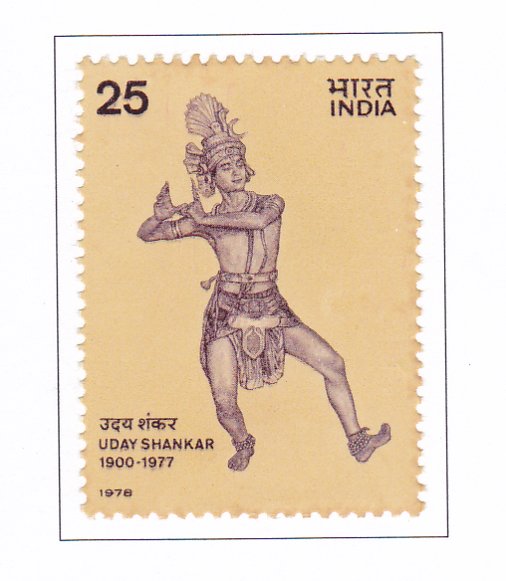Uday Shankar (1900-1977) Commemoration

Technical Data
| Date of Issue | September 26, 1978 |
|---|---|
| Denomination | 25 p |
| Quantity | 3,000,000 |
| Perforation | comb 13 |
| Printer | Security Printing Press, Nashik |
| Watermark | No Watermark |
| Colors | Multicolor |
| Catalog Codes |
Michel IN 770 Stamp Number IN 807 Yvert et Tellier IN 566 Stanley Gibbons IN 897 |
| Themes | Commemoration | Dance | Folklore | Suits and Costumes |
Uday Shankar was born on December 8, 1900, in Udaipur, the eldest son of Dr. Shyam Shankar Chowdhury, an educationist. He spent his childhood in Ghazipur. Disliking school, he often snuck away to watch dance performances, sparking his early interest in the art form. Uday Shankar was later sent to school in Varanasi and then attended the J. J. School of Arts in Bombay. In 1920, he traveled to England and enrolled at the Royal College of Arts, London, initially pursuing Western painting under Sir William Rothenstein. However, he eventually embraced a dancing career in 1922, influenced by Anna Pavlova, Europe’s leading Ballerina at the time.
Uday Shankar ventured into running a school of dancing in Almora in 1939 and producing a film titled “Kalpana”. Renowned for his originality as a dancer and idealism as a choreographer, he achieved notable milestones in dance. He was the first to present an Indian ballet with indigenous themes, accompanied by music devoid of foreign instruments. Uday Shankar and his troupe extensively toured Europe, America, and other regions, earning him recognition as a prominent cultural ambassador of his time.
His significant contribution lay in blending Indian classical style with Western ballet and various folk dances. Drawing inspiration from Indian mythology and temple sculpture, he infused his creations with imaginative ideas about costumes, decor, and music. Notable examples of his synthesis include renowned performances like “Shivatandava”, “Gajasurabadh”, “Kartikeya”, “Indra”, and “Labour and Machine”. He passed away on September 26, 1977, leaving behind a legacy of innovation and artistic excellence in dance.
